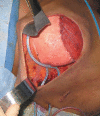Safe and Efficient Implant-based Breast Reconstruction
- PMID: 33133973
- PMCID: PMC7544319
- DOI: 10.1097/GOX.0000000000003134
Safe and Efficient Implant-based Breast Reconstruction
Abstract
Implant-based breast reconstruction is a safe and effective option associated with high patient satisfaction. Techniques have evolved significantly over the past several decades, characterized mostly by a reduction in the number of stages and time required to complete reconstruction, with maximal preservation of native breast elements. Nevertheless, both old and new techniques of implant-based breast reconstruction have a role depending on the specific clinical scenario, and thus plastic surgeons should be well versed in the full spectrum of options. This article reviews the key considerations underlying decision-making in implant-based breast reconstruction and the most effective techniques, with a focus on optimizing safety and efficiency.
Copyright © 2020 The Author. Published by Wolters Kluwer Health, Inc. on behalf of The American Society of Plastic Surgeons.
Conflict of interest statement
Disclosure: The author has no financial interest to declare in relation to the content of this article.
Figures





Similar articles
-
Long-term Patient-Reported Outcomes in Postmastectomy Breast Reconstruction.JAMA Surg. 2018 Oct 1;153(10):891-899. doi: 10.1001/jamasurg.2018.1677. JAMA Surg. 2018. PMID: 29926096 Free PMC article. Clinical Trial.
-
2020 special issue: Twenty years of breast reconstruction: Past, present, and future.Breast J. 2020 Jan;26(1):39-41. doi: 10.1111/tbj.13716. Breast J. 2020. PMID: 31971345
-
Preferences in choosing between breast reconstruction options: a survey of female plastic surgeons.Plast Reconstr Surg. 2009 Dec;124(6):1781-1789. doi: 10.1097/PRS.0b013e3181bf8056. Plast Reconstr Surg. 2009. PMID: 19952634
-
Strategies and considerations in selecting between subpectoral and prepectoral breast reconstruction.Gland Surg. 2019 Feb;8(1):11-18. doi: 10.21037/gs.2018.08.01. Gland Surg. 2019. PMID: 30842923 Free PMC article. Review.
-
Breast Reconstruction: Necessity for Further Standardization of the Current Surgical Techniques Attempting to Facilitate Scientific Evaluation and Select Tailored Individualized Procedures Optimizing Patient Satisfaction.Breast Care (Basel). 2021 Dec;16(6):574-583. doi: 10.1159/000518745. Epub 2021 Sep 9. Breast Care (Basel). 2021. PMID: 35087360 Free PMC article. Review.
Cited by
-
Effect of hypothyroidism on short-term outcomes after autologous and implant-based breast reconstruction.Updates Surg. 2024 Oct;76(6):2351-2359. doi: 10.1007/s13304-024-01791-w. Epub 2024 Mar 15. Updates Surg. 2024. PMID: 38489128
-
ASO Author Reflections: Immediate Implant-Based Versus Autologous-Based Breast Reconstruction After Mastectomy in Patients with Breast Cancer.Ann Surg Oncol. 2025 Mar;32(3):2108-2109. doi: 10.1245/s10434-024-16374-7. Epub 2024 Oct 12. Ann Surg Oncol. 2025. PMID: 39395916 No abstract available.
-
African Americans have worse in-hospital outcomes in autologous and implant-based breast reconstruction: a population-based study from the National Inpatient Sample from 2015 to 2020.Updates Surg. 2024 Oct;76(6):2361-2369. doi: 10.1007/s13304-024-01914-3. Epub 2024 Jun 27. Updates Surg. 2024. PMID: 38935206
-
Robotics in Implant-Based and Autologous Breast Reconstruction.Semin Plast Surg. 2023 Aug 3;37(3):168-175. doi: 10.1055/s-0043-1771235. eCollection 2023 Aug. Semin Plast Surg. 2023. PMID: 38444960 Free PMC article. Review.
-
Predictors of 30-day Hospital Readmission after Autologous vs. Implant-based Breast Reconstruction: A 16-year Analysis of 175,474 Patients.J Plast Reconstr Surg. 2024 May 10;3(4):142-150. doi: 10.53045/jprs.2023-0066. eCollection 2024 Oct 27. J Plast Reconstr Surg. 2024. PMID: 40104562 Free PMC article.
References
-
- Macadam SA, Ho AL, Cook EF, Jr, et al. Patient satisfaction and health-related quality of life following breast reconstruction: patient-reported outcomes among saline and silicone implant recipients. Plast Reconstr Surg. 2010;125:761. - PubMed
-
- Albornoz CR, Bach PB, Mehrara BJ, et al. A paradigm shift in U.S. Breast reconstruction: increasing implant rates. Plast Reconstr Surg. 2013;131:15–23. - PubMed
-
- Margenthaler JA, Gan C, Yan Y, et al. Oncologic safety and outcomes in patients undergoing nipple-sparing mastectomy. J Am Coll Surg. 2020;230:535–541. - PubMed
-
- National Comprehensive Cancer Network (NCCN). NCCN clinical practice guidelines in oncology: breast cancer. Available at https://www.nccn.org/professionals/physician_gls/pdf/breast.pdf. Accessed June 29, 2020. - PubMed
-
- Colwell AS, Tessler O, Lin AM, et al. Breast reconstruction following nipple-sparing mastectomy: predictors of complications, reconstruction outcomes, and 5-year trends. Plast Reconstr Surg. 2014;133:496–506. - PubMed
Publication types
LinkOut - more resources
Full Text Sources
Miscellaneous
